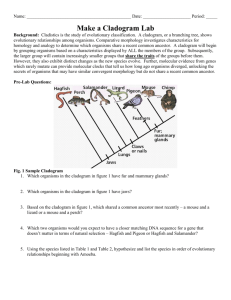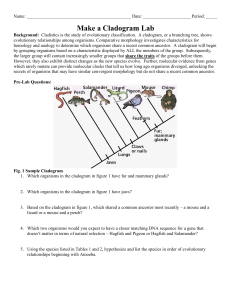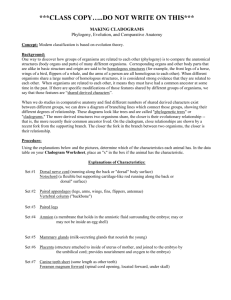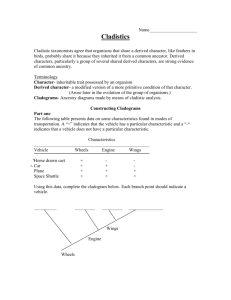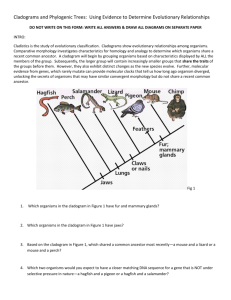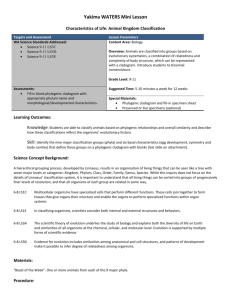Cladogram Activity
advertisement
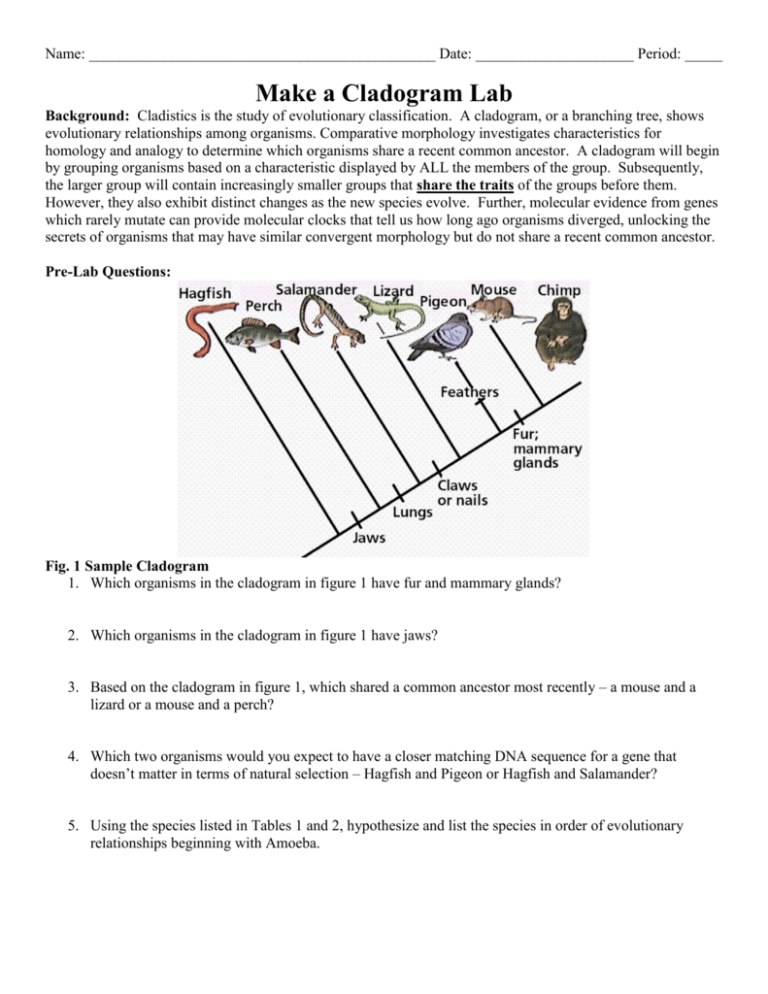
Name: ______________________________________________ Date: _____________________ Period: _____ Make a Cladogram Lab Background: Cladistics is the study of evolutionary classification. A cladogram, or a branching tree, shows evolutionary relationships among organisms. Comparative morphology investigates characteristics for homology and analogy to determine which organisms share a recent common ancestor. A cladogram will begin by grouping organisms based on a characteristic displayed by ALL the members of the group. Subsequently, the larger group will contain increasingly smaller groups that share the traits of the groups before them. However, they also exhibit distinct changes as the new species evolve. Further, molecular evidence from genes which rarely mutate can provide molecular clocks that tell us how long ago organisms diverged, unlocking the secrets of organisms that may have similar convergent morphology but do not share a recent common ancestor. Pre-Lab Questions: Fig. 1 Sample Cladogram 1. Which organisms in the cladogram in figure 1 have fur and mammary glands? 2. Which organisms in the cladogram in figure 1 have jaws? 3. Based on the cladogram in figure 1, which shared a common ancestor most recently – a mouse and a lizard or a mouse and a perch? 4. Which two organisms would you expect to have a closer matching DNA sequence for a gene that doesn’t matter in terms of natural selection – Hagfish and Pigeon or Hagfish and Salamander? 5. Using the species listed in Tables 1 and 2, hypothesize and list the species in order of evolutionary relationships beginning with Amoeba. Procedure: Part I Morphological Evidence: Cytochrome c is a protein located in the mitochondria of cells involved with cellular respiration. Compare each organism’s Cytochrome c DNA sequences with the ancestor cell and each other. Circle or highlight the differences (mutations) present in the cytochrome c DNA sequences from ancestor cell. Part II: Molecular Evidence: Using your text and prior knowledge, determine the morphological characteristics of the organisms in table 1. For every characteristic the organism possesses, put a check in that box. Table 1: Comparative Morphology Data Organism Multicellular Segmented body Jaws Limbs (not fins) Hair Has bone Amoeba Sponge Earthworm Shark Lizard Kangaroo Dolphin Cat Table 2: Cytochrome c DNA Sequence Data Organism DNA Sequence Ancestor Cell A T T A G C G A C C A G T A T A T C C T A C A A T C C G T C T A C T T C A T T ATTAGCGACCAGTTTATCCTACAATCCCGTCTACTTCAT Amoeba ATTATCGACCAGTTTATCCTACATTCCCGTCTACTTCGT Sponge CTTATCGACCCGTTTATCCTACATTCCCGTCTACTTCGT Earthworm CTTATCCCCCCGTTTATCCTACTTTCCCGTCTACTTCGT Shark CTAATCCCCCCGTTTATCCTACTTTCCCGTCTACTTCGT Lizard CTAATCCCCCCGTTTATCCTACTTTCCCATCTACTAAGT Kangaroo CTAATCCCCCCGTTTATCCTACTTTCCCATGTAGTAAGT Dolphin TTAATCCCCCCGTTTATCCTACTTTCCCATCTACTAAGT Cat # mutations 0 Part III - On your own sheet of paper, create a Venn Diagram to show the relatedness of these organisms. Start with the trait that is shared by all the organisms on the outside. Inside each box, write the organisms that have only that set of traits. Part IV— On your own sheet of paper, create a cladogram based on the morphological and molecular evidence. Post Lab Discussion Questions: 1. How did your hypothesis in the pre-lab compare to the cladogram in part IV? 2. Which type of evidence for evolution is most accurate in determining evolutionary relationships – morphology or molecular and why?
